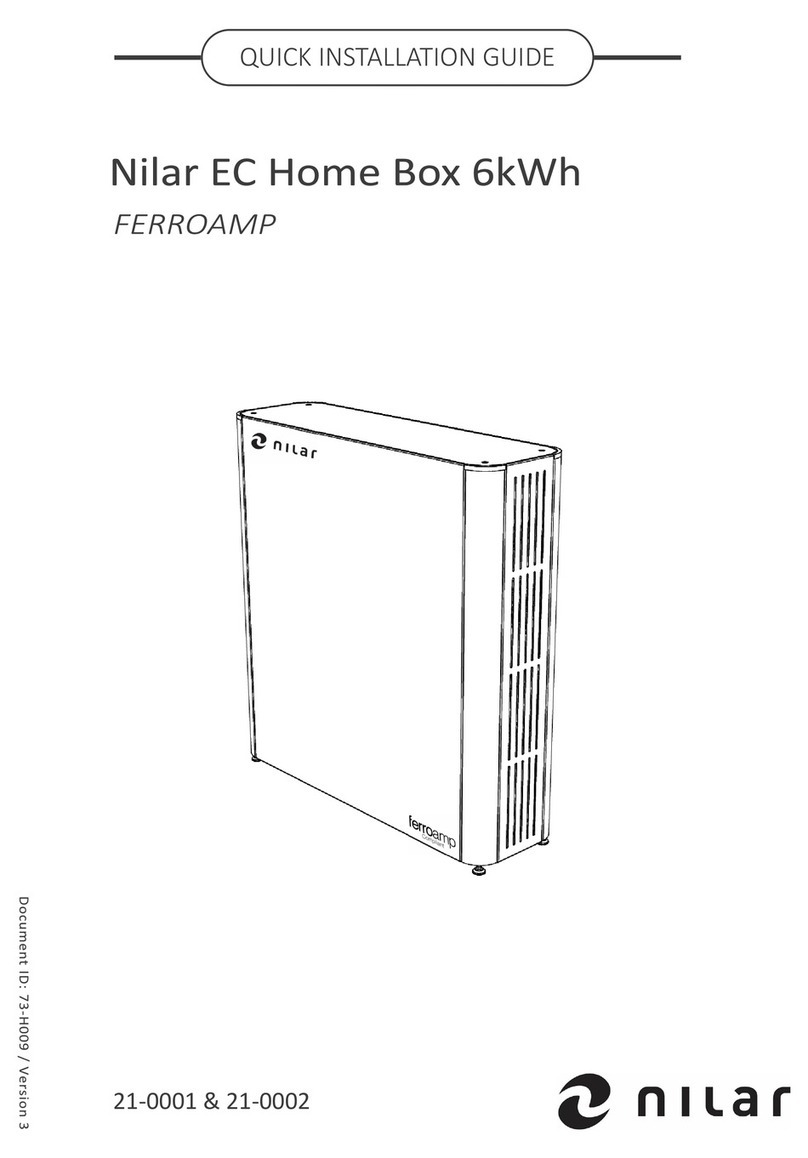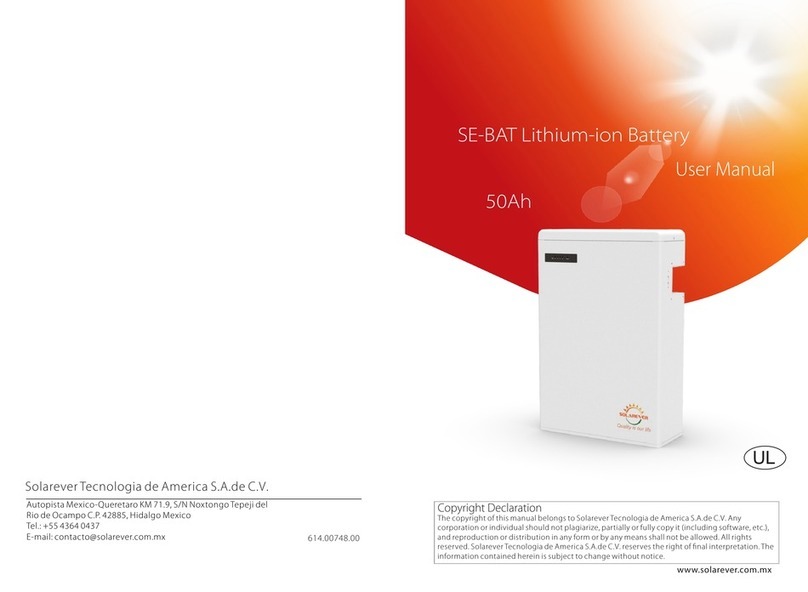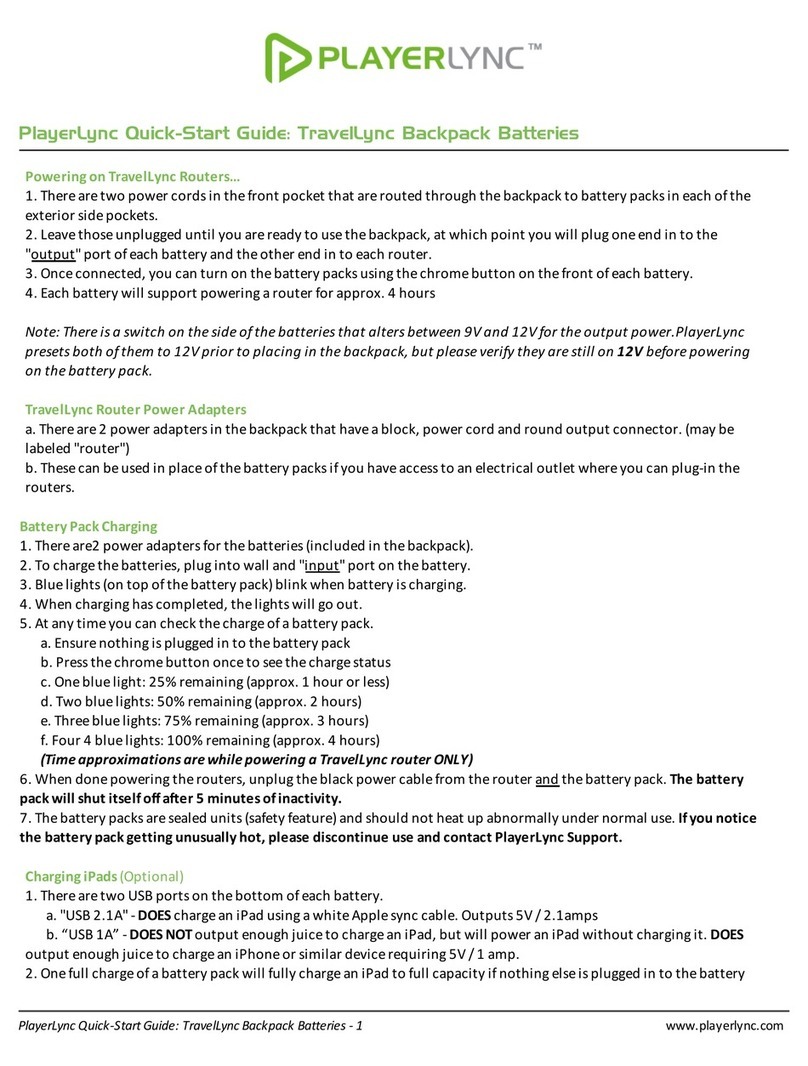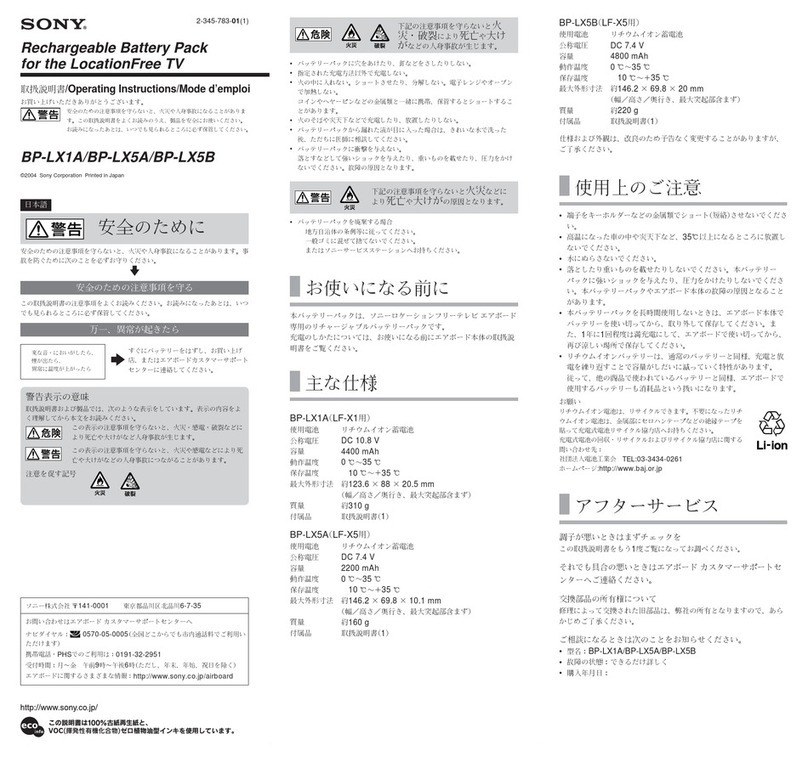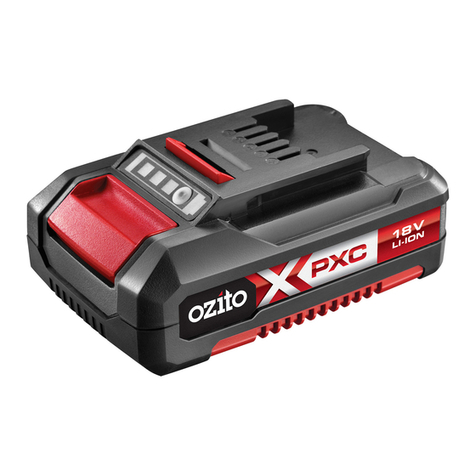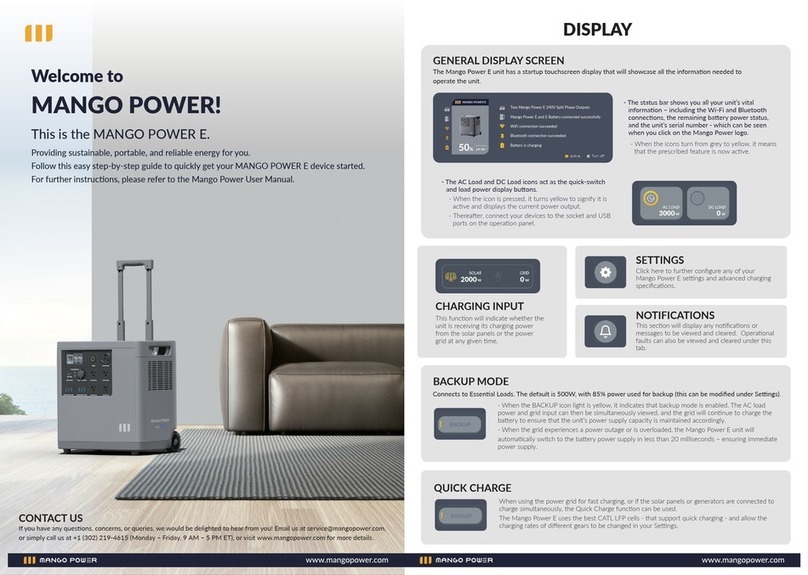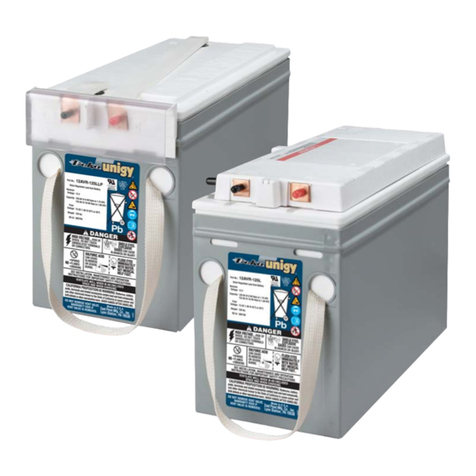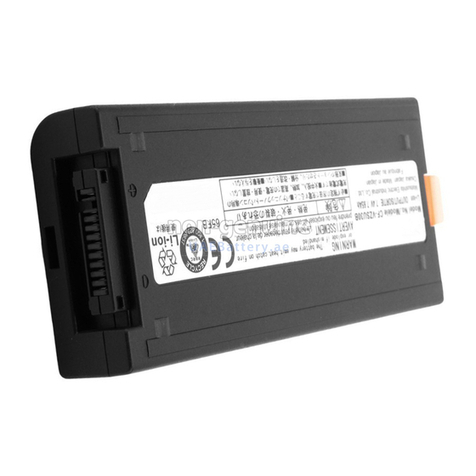Nilar ReOx 1 User manual

Document ID: 73-H001. Copyright © Nilar AB. All rights reserved.
Page 0 (39)

INSTRUCTION MANUAL
Thank you for purchasing a Nilar product.
It is required to read and understand these instructions carefully for a safer installation and operation, as well as
optimum performance and longer service life.
Keep this manual in a safe place for future reference.
This manual may be modified and updated without prior notice. Contact Nilar for validation.
Colours used in illustrations, e.g., for cables, are only illustrative and might deviate from the actual colour.
Without written permission from Nilar, this manual is not to be copied or transferred for other purposes, neither in its
entirety nor parts of it.
The product described in this manual is manufactured in compliance with the Low Voltage Directive (LVD) 2014/35/EU,
the Electromagnetic Compatibility Directive (EMCD) 2014/30/EU, and Restrictions of Hazardous Substances (RoHS)
Directive 2011/65/EU.
The product contains metal hydride battery packs that follow the EU-directive 2006/66/EC (‘Battery Directive’). The
battery packs do not contain the heavy metals lead, mercury, or cadmium.
The product adheres to the Waste Electrical and Electronic Equipment (WEEE) Directive 2012/19/EU. This means that
the manufacturer/importer is responsible for the manufactured products being collected, taken care of, and recycled
after they have reached the end of their lifespan.
Nilar products are in compliance with EU regulation (EC) No. 1907/2006 concerning the Registration, Evaluation,
Authorization, and restriction of Chemicals (REACH). We check that our suppliers comply with REACH requirements for
all the materials and components they deliver to us.
©Nilar AB. All rights reserved.
Document identification: 73-H028
Version
Status
Date
1.0
Released for ReOx 1
2022-12-07

INSTRUCTION MANUAL
This manual will give you, as a reader, all the necessary instructions for more professional and safer handling of the
product. Read the manual carefully to avoid mistakes and risks. The manual is divided into the following chapters:
Chapter
Content
1. Safety Information
General safety information
2. Technical Support and Warranty
References
3. Environment
Content, recycling
4. Function description
General description of the product
5. Transportation, lifting, and storage
Instructions, conditions
6. Installation
Instructions for installation
7. Operation
Operational conditions
8. Maintenance
Advises, schedules
9. Decommissioning
Instructions, references
10. Troubleshooting
Self-help

INSTRUCTION MANUAL
Table of contents
1. Safety Information...........................................................................................................................1
1.1 Safety markings in this instruction.................................................................................................................. 1
1.2 General warnings and cautions ...................................................................................................................... 1
2. Technical support and warranty......................................................................................................3
3. Environment ....................................................................................................................................4
3.1 Compliance..................................................................................................................................................... 4
4. Function description........................................................................................................................5
4.1 Datasheet ....................................................................................................................................................... 5
4.2 Battery pack specification and build-up.......................................................................................................... 6
4.3 Front of the battery pack................................................................................................................................ 7
4.4 Connections IMU............................................................................................................................................ 9
4.5 Signals IMU................................................................................................................................................... 10
4.6 Reoxygenating (ReOx)........................................................................................................................................ 11
5. Transportation, lifting, and storage ...............................................................................................12
5.1 Transportation.............................................................................................................................................. 13
5.2 Moving and lifting......................................................................................................................................... 14
5.3 Storage ......................................................................................................................................................... 14
6. Installation .....................................................................................................................................15
6.1 General conditions on-site............................................................................................................................ 16
6.2 Preparation of connections before installation ............................................................................................ 17
6.3 Orientation and placement of battery pack.................................................................................................. 17
6.4 Installation of a single battery pack .............................................................................................................. 18
6.5 Series connection of battery packs to form a battery string......................................................................... 20
7. Operation.......................................................................................................................................23
7.1 Charging........................................................................................................................................................ 23
7.2 Discharging ................................................................................................................................................... 24
7.3 Resistance..................................................................................................................................................... 24
7.4 Self-discharge ............................................................................................................................................... 24
7.5 Cycle life ....................................................................................................................................................... 24

INSTRUCTION MANUAL
8. Maintenance..................................................................................................................................25
8.1 Protective measures during maintenance .................................................................................................... 25
9. Decommissioning...........................................................................................................................26
9.1 Temporarily decommissioning...................................................................................................................... 26
9.2 Permanent decommissioning ....................................................................................................................... 26
9.3 Damage......................................................................................................................................................... 26
10. Troubleshooting............................................................................................................................27
11. Appendix 1: Information bulletin, IT-grounding ..........................................................................28

INSTRUCTION MANUAL
Figures
Figure 1: Indication of the serial number on the battery pack ...................................................................................................3
Figure 2: Overview of 144 V and 120 V battery packs incl. IMU (from left to right) .................................................................5
Figure 3: Build-up of a 144 V battery pack with IMU ..................................................................................................................5
Figure 4: Measurement illustration of 144 V battery pack with length incl. IMU .....................................................................6
Figure 5: Parts of 144 V Battery pack excl. IMU...........................................................................................................................6
Figure 6: 144 V Battery pack .........................................................................................................................................................7
Figure 7: Design, positive (+) chassis connector, type Phoenix 1805180...................................................................................8
Figure 8: Design, negative (-) chassis connector, type Phoenix 1805177 ..................................................................................8
Figure 9: Design, positive (+) cable connector, type Phoenix 1774674 .....................................................................................8
Figure 10: Design, negative (-) cable connector, type Phoenix 1774687...................................................................................8
Figure 11: Disconnection of cable connectors.............................................................................................................................8
Figure 12: Overview of IMU with the cover lid removed ............................................................................................................9
Figure 13: CAN connector, Shielded RJ45 ..................................................................................................................................10
Figure 14: 144 V Battery pack with IMU on front and location of ReOx connector ................................................................11
Figure 15: Orientation of battery pack.......................................................................................................................................12
Figure 16: Battery pack incl. lifting straps ..................................................................................................................................14
Figure 17: Orientation of battery pack.......................................................................................................................................17
Figure 18: Before and after placement of battery pack on insulation tray..............................................................................18
Figure 19: Before and after cover lid removal ...........................................................................................................................18
Figure 20: Installation of CAN connection into CAN port on IMU ............................................................................................19
Figure 21: Installation of negative (-) cable before connection (IMU connections not displayed).........................................19
Figure 22: Installation of negative (-) cable after connection (IMU connections not displayed)............................................19
Figure 23: Installation of positive (+) cable before connection (IMU connections not displayed) .........................................20
Figure 24: Installation of positive (+) cable after connection (IMU connections not displayed) ............................................20
Figure 25: Finished installation of interpack cable between the ‘first’ and ‘secondary’ battery pack (IMU connections are
not displayed) ..............................................................................................................................................................................22
Figure 26: Finished installation of interpack cable between the ‘first’, ‘second’, third, and ‘fourth’ battery packs (IMU
connections are not displayed)...................................................................................................................................................22
Figure 27: Finished installation of interpack cable between the ‘first’, ‘second’, third, and ‘fourth’ battery packs and
cables from the BMS (IMU connections are not displayed)......................................................................................................22
Figure 28: WEEE symbol for separate disposal..........................................................................................................................26

INSTRUCTION MANUAL
Tables
Table 1: Technical specification of ReOx 1 battery pack in various sizes @ +20oC....................................................................5
Table 2: Description of visual signals............................................................................................................................................9

1. SAFETY INFORMATION
Document ID: 73-H028. Copyright © Nilar AB. All rights reserved. Page 1 (39)
1. Safety Information
This chapter contains safety information that applies to
the Nilar battery pack.
To avoid personal injury, do not perform any service
unless you are qualified. Refer to all safety summaries
before installing, operating, maintaining, and
decommissioning. For a more detailed specification
regarding safety, contact Nilar.
1.1 Safety markings in this instruction
1.2 General warnings and cautions
WARNING! Wear electrically insulated gloves when
handling a battery pack. Battery pack surfaces may carry
hazardous voltage due to lowered insulation resistance.
Do not place battery packs on conductive surfaces.
WARNING! Risk for electric shock and arcing if the
product is misused or electrically installed incorrectly.
WARNING! The battery packs cannot be switched off.
Please note:
•Work only with one battery pack terminal at a
time.
•The printed circuit board (PCB); Integrated
Monitoring Unit (IMU) at the front of the battery
pack may have hazardous voltage.
•The rupture disc may release electrolyte during
abnormal use. We, therefore, recommend
wearing safety glasses.
WARNING! Risk for electrical hazards if the product is
exposed to rain or moisture.
WARNING! Never install a damaged battery pack or a
damaged insulation tray.
WARNING! If a battery fire occurs, it can be extinguished
by using CO2. Ensure that fire extinguishers are
available.
WARNING! Do not operate the product with suspected
failures. If you suspect the product is damaged, have it
inspected by qualified service personnel.
WARNING! Do not block or cover the rupture disc outlet
at the back of the battery pack.
CAUTION! To avoid potential hazards, use this product
only as specified.
CAUTION! Do not install other battery chemistry types or
batteries together with Nilar’s battery packs.
CAUTION! If the battery pack(s) is damaged
mechanically, the following may occur:
•High heat generation on battery pack surface.
•Electrolyte may escape.
•The smoke from burning battery packs can irritate the
skin, eyes and respiratory system.
Therefore, follow these guidelines:
•Do not open the battery pack.
•Do not modify or mechanically damage the battery
pack or its cables
•Operate the battery pack only within the allowed
operating range.
•Do not short-circuit the battery pack(s).
•Do not continue to use the battery pack after
identified as faulty.
CAUTION! Do not install or place the products in direct
sunlight for a longer time to avoid potential damage to
plastics on the battery pack and insulation tray.
CAUTION! Do not expose the battery pack or insulation
tray to heat or fire.
The exclamation mark within an
equilateral triangle is intended to
alert the user that negligence of
this information can be life
threatening.
WARNING!
The exclamation mark within a
circle is intended to alert the user
that negligence of this information
can be associated with bodily
injury and/or damage to the
product.
CAUTION!

1. SAFETY INFORMATION
Document ID: 73-H028. Copyright © Nilar AB. All rights reserved. Page 2 (39)
CAUTION! Do not operate the product with the covers
removed. If covers are removed during, e.g., repair, do
not touch any exposed connections.
CAUTION! The product shall not be exposed to liquids
(not even dripping or splashing), and objects filled with
liquids shall not be placed on or close to the product.
CAUTION! The product shall be installed inside an
enclosure with panels and doors that only a key or
screws can open.
CAUTION! Remove personal metal items from hands,
wrists and neck, such as rings, bracelets, necklaces, and
watches, when physically handling the product since it
can result in a short-circuit current, causing a severe
burn. Please note:
•We recommend using tools rated to 1000 VAC
according to EN 60900.
•We recommend using flame-resistant protective
clothing according to EN 61482-1-1 and rated as
minimum class 1 according to EN 61482-1-2.
CAUTION! Keep product surfaces clean and dry.

2. TECHNICAL SUPPORT AND WARRANTY
Document ID: 73-H028. Copyright © Nilar AB. All rights reserved. Page 3 (39)
2. Technical support and warranty
The battery pack’s serial number can be found on the
side of the battery pack at the top ①.
①
Figure 1: Indication of the serial number on the battery pack
Please see the separate document for the detailed
warranty and conditions.
Please make sure to always have
your serial number of your
product(s) available for warranty
and technical support matters.
CAUTION!

3. ENVIRONMENT
Document ID: 73-H028. Copyright © Nilar AB. All rights reserved. Page 4 (39)
3. Environment
This chapter will inform about how the Nilar battery
pack is recycled.
When the Nilar battery pack has reached its end of life
(EOL), Nilar takes full responsibility for the recycling
process by accepting the complete battery packs back.
Contact your local Nilar representative for more
information. The recycling process ensures that most
materials are reused or recycled appropriately.
3.1 Compliance
Nilar products are compliant with the following
environmental directives and regulations:
•EU-Directive 2006/66/EC (‘Battery Directive’).
The battery pack(s) do not contain the heavy
metals lead, mercury or cadmium.
•Waste Electrical and Electronic Equipment
(WEEE) Directive 2012/19/EU.
•Restrictions of Hazardous Substances according
to RoHS Directive 2011/65/EU.
•Nilar products comply with EU regulation (EC)
No. 1907/2006 concerning the Registration,
Evaluation, Authorisation and Restriction of
Chemicals (REACH).

4. FUNCTION DESCRIPTION
Document ID: 73-H028. Copyright © Nilar AB. All rights reserved. Page 5 (39)
4. Function description
This chapter will describe the functions of the various
parts of the battery pack.
Figure 2: Overview of 144 V and 120 V battery packs incl. IMU (from left to right)
Figure 3: Build-up of a 144 V battery pack with IMU
1
For more information, see section 6.1.2 Humidity and ventilation
4.1 Datasheet
Table 1: Technical specification of ReOx 1 battery pack in various sizes @ +20oC
Properties
96V
108V
120V
144V
Unit
Rated energy
0.96
1.08
1.20
1.44
kWh
Nominal
voltage
96
108
120
144
VDC
Max.
continuous
charging power
0.96
1.08
1.20
1.44
kW
Max.
continuous
discharging
power
0.96
1.08
1.20
1.44
kW
Dimensions
(LxHxW)
246 x
306 x
127
269 x
306 x
127
291 x
306 x
127
335 x
306 x
127
mm
Weight
24
26
29
34
kg
Ingress
protection
(Battery pack)
20
20
20
20
IP
Battery pack
voltage range
80-132
90-144
100-160
120-192
V
Min - Max.
allowed
ambient
humidity
(without
condensation)1
5 –55
5 –55
5 –55
5 –55
% RH
Ambient
operating
temperature
0 to +30
0 to +30
0 to +30
0 to +30
oC
Battery pack
operating
temperature
0 to +55
0 to +55
0 to +55
0 to +55
oC
Allowed
ambient
temperature
for handling
-20 to
+40
-20 to
+40
-20 to
+40
-20 to
+40
oC
Overvoltage
category
III
III
III
III
Category
EMC
EN 61000-6-2:2005 (Immunity)
EN 61000-6-3:2007 (Emission)
IEC
Maximum
installation
altitude
2000
2000
2000
2000
m (a.s.l.)

4. FUNCTION DESCRIPTION
Document ID: 73-H028. Copyright © Nilar AB. All rights reserved. Page 6 (39)
4.2 Battery pack specification and build-up
A battery pack can contain between 8 and 12 modules
(12 VDC per module), and each module always contains
10 battery cells.
Battery packs are designed to be used in systems with a
maximum system voltage of up to 800 VDC. The
maximum voltage is obtained during charging, namely
when fully charged.
Note! The following measurements do not include the
additional space that is required for an insulation tray, which is
mandatory for all installations (see section 6.3 Orientation
and placement of battery pack).
Figure 4: Measurement illustration of 144 V battery pack with length incl. IMU
①
②
③
④
⑤
Figure 5: Parts of 144 V Battery pack excl. IMU
4.2.1 Rupture disc (① not displayed)
The Nilar battery pack is fitted with a ‘rupture disc’that
is activated when the pressure is too high. The rupture
disc is located on the rear side of the battery pack. The
rupture disc is only activated under abusive conditions.
4.2.2 Module voltage terminals (②)
Each module provides the IMU (see section 4.5.1
Module voltages) with voltage through the
module voltage terminals. From each module’s pole
terminal (first to last), there is a cable to the IMU.
306 mm
335 mm
127 mm

4. FUNCTION DESCRIPTION
Document ID: 73-H028. Copyright © Nilar AB. All rights reserved. Page 7 (39)
4.2.3 End pieces (③, blue ●)
There is one end piece on each side of the battery pack
to ensure the required compression.
4.2.4 Steel strapping bands (④, black ●)
The battery pack is bound together by three (3) isolated
steel strapping bands, and their function is both to hold
the modules together and to ensure the correct
compression for the battery pack.
4.2.5 Module (⑤, black and white cream ●●)
The 12 V module is the building block for all Nilar
battery packs. Ten (10) cells are connected in series to
create modules with a rated capacity of 10 Ah and
nominal voltages of 12 VDC.
4.3 Front of the battery pack
The Integrated Monitoring Unit (IMU) is attached to the
front of the battery pack behind the cover lid, with one
IMU per battery pack.
Positive terminal (+)
Negative terminal (-)
Cover lid for connections of IMU
Figure 6: 144 V Battery pack

4. FUNCTION DESCRIPTION
Document ID: 73-H028. Copyright © Nilar AB. All rights reserved. Page 8 (39)
4.3.1 Negative (-) and positive (+) terminals
The terminal posts are located on the upper side of the
IMU. The connections are ‘Phoenix Sunclix PV, chassis
connector’type. The cables to connect the battery
packs need to have the connection type ‘Phoenix
Sunclix PV, cable connector’. A flat screwdriver is
required to detach the assembled male and female
connection. The chassis-mounted terminals come as
standard equipment with the battery pack.
Figure 7: Design, positive (+) chassis connector, type Phoenix 1805180
Figure 8: Design, negative (-) chassis connector, type Phoenix 1805177
Figure 9: Design, positive (+) cable connector, type Phoenix 1774674
Figure 10: Design, negative (-) cable connector, type Phoenix 1774687
In order to detach the assembled male and female
connection, a flat screwdriver is needed.
Figure 11: Disconnection of cable connectors
Never detach the assembled male
and female connection during load.
This is related to electrical arcs or
sparks hazards.
WARNING!

4. FUNCTION DESCRIPTION
Document ID: 73-H028. Copyright © Nilar AB. All rights reserved. Page 9 (39)
4.4 Connections IMU
All connections for the IMU are to be found under the
cover lid.
①
②
③
④
⑤
Figure 12: Overview of IMU with the cover lid removed
4.4.1 Reset button (①)
By pushing the Reset button, the IMU will be manually
restarted.
4.4.2 Operation LED (②)
The operation LED indicates the status of the IMU, as
displayed in the following table.
Table 2: Description of visual signals
Visual signal
State
●Green
Normal mode (system measuring is
active)
●Red
Active alarm
●Yellow
Start-up sequence (IMU requests
settings input from superior control
system)
●White
Automatic addressing on IMU
An IMU that is running in normal mode will flash:
Green →off →Green →off etc.
An IMU that does not have the correct safety pulse IN
will have static light:
Yellow
An IMU that is in addressing mode will flash:
White →off →White →off etc.
An IMU that is in addressing mode with no safety pulse
IN will have a static light:
White
An IMU with an active safety alarm will replace the
green signal and hence flash:
Red →off →Red →off etc.

4. FUNCTION DESCRIPTION
Document ID: 73-H028. Copyright © Nilar AB. All rights reserved. Page 10 (39)
4.4.3 Communication connections, (③)
Connections that are available on the IMU are as
follows:
④ CAN + safety IN (From SCU or IMU)
⑤CAN + safety OUT (to SCU or IMU)
The CAN connections (type: RJ45/8P8C shielded) are
used as input and output per battery pack in order to
series connect the battery string for communicating
with the IMU as described in section 4.5 Signals
IMU.
Figure 13: CAN connector, Shielded RJ45
4.5 Signals IMU
The IMU monitors the following signals and
communicates them to the Battery Management
System (BMS), which is briefly explained in subsequent
sections.
For more detailed descriptions, please see the
Integrations Manual for BMS 3.0, 73-H027.
4.5.1 Module voltages
The voltage monitors measure the voltage of each
module. An alarm will be triggered if the actual voltage
is out of the defined range.
In addition to the module voltages, the combined
voltage of the battery pack is also measured and
presented as a total battery pack voltage value.
4.5.2 Pressure sensor
An internal battery pressure sensor measures the
relative pressure in each battery pack. Due to the
common gas channel in the Nilar bipolar pack design, all
the cells in the battery pack have the same pressure. If
the pressure is out of the defined range, an alarm will
be triggered and communicated to the BMS to prevent
damage due to high pressure.
4.5.3 Battery temperature
There is a temperature sensor in each battery pack that
measures the temperature. If the temperature exceeds
the defined range, an alarm will be triggered and
communicated to the BMS to prevent the battery from
overheating.
4.5.4 Safety
A safety circuit is built into the IMU and monitors the
battery packs’pressure and temperature.

4. FUNCTION DESCRIPTION
Document ID: 73-H028. Copyright © Nilar AB. All rights reserved. Page 11 (39)
4.6 Reoxygenating (ReOx)
Nilar’s battery pack is fitted with a connector for the
Reoxygenating service. The connector is only for the
Reoxygenating service and should not be used in normal
operation.
Nilar performs the Reoxygenating service of the battery
pack(s). Please contact Nilar for more information about
when your battery pack(s) needs a reoxygenating
service.
ReOx connector
Figure 14: 144 V Battery pack with IMU on front and location of ReOx connector
Do not modify or mechanically
damage the pneumatic ReOx
connection. Hydrogen and oxygen
might escape from the inside of the
battery pack.
WARNING!
Do not connect anything to the
pneumatic ReOx connection
without permission and instructions
from Nilar. Hydrogen and oxygen
might escape from the inside of the
battery pack.
WARNING!

5. TRANSPORTATION, LIFTING, AND STORAGE
Document ID: 73-H028. Copyright © Nilar AB. All rights reserved. Page 12 (39)
5. Transportation, lifting, and storage
This chapter deals with Nilar products’ required
conditions when transported, moved, lifted, and stored.
The battery packs must always be placed in an upright
position (with the terminals in the upper position)
during transportation and storage:
Figure 15: Orientation of battery pack
Battery pack surfaces may carry
hazardous voltage due to lowered
insulation resistance. Always
transport and/or store the battery
packs on insulating (non-
conductive) surfaces.
WARNING!
Please make sure that the battery
packs are positioned in the correct
way during transportation and
storage. If the battery pack tips over
turn it up as soon as possible.
CAUTION!
Always wear Personal Protective
Equipment (PPE) when handling
battery packs. At minimum this
includes:
Safety glasses, safety shoes with
steel toe and electrically insulated
gloves.
CAUTION!

5. TRANSPORTATION, LIFTING, AND STORAGE
Document ID: 73-H028. Copyright © Nilar AB. All rights reserved. Page 13 (39)
5.1 Transportation
When transporting Nilar products, some preparations
and precautions must be taken, which will be described
in this part of the chapter.
5.1.1 Packaging, duration and outside conditions
Nilar battery packs are delivered well-protected in their
original packaging. Nevertheless, transport damages can
occur. If any transport damage is discovered:
•Document the damage
•Report the damage to the responsible logistics
company
•Contact your local Nilar representative
If undamaged, we advise keeping the original packaging
for future transportation. If this is not possible, please
get in touch with your local Nilar representative.
Transport duration, incl. storage, shall be made at an
ambient temperature of −20°C to +40°C.
5.1.2 Transportation regulations of Battery packs
Nilar battery packs do not require UN-approved
packaging or marking when transported by sea, road,
rail, or air.
No dangerous goods documentation is required when
transporting Nilar battery packs by road or rail.
A dangerous goods declaration is required if battery
packs are transported by sea in quantities of over 100
kg in one transport unit. Nilar battery packs are then
defined as dangerous goods, class 9. UN number and
Proper Shipping Name (PSN) are UN 3496, and
Batteries, Nickel Metal Hydride, respectively.
An Air Waybill or similar is required if battery packs are
transported by air. Nilar battery packs are not classified
as dangerous goods and belong to the entry Batteries,
dry in the list of dangerous goods in IATA (no UN
number). If an Air Waybill is used, the words ‘Not
Restricted’ and the Special Provision number (A123)
must be included in the description of the substance on
the Air Waybill, according to IATA-DGR.
The battery packs must be separated from each other
to prevent short circuits and be securely packed to
prevent movement that could lead to short circuits;
Nilar’s original packaging ensures that this cannot occur.
Please observe that special regulations apply for
defective or damaged battery packs that can potentially
lead to a hazardous event during transportation. Please
contact your local Nilar representative for advice
regarding transporting damaged or defective battery
packs.
When performing the visual
inspection, it is important not to
remove the battery packs from their
original Nilar sealed plastic
packaging.
CAUTION!
It is important to always pack the
battery packs in their original Nilar
sealed plastic packaging with
moisture-absorbent bags if being
transported.
CAUTION!
The Nilar product package shall
under no circumstances be exposed
to rain.
CAUTION!
Table of contents
Other Nilar Batteries Pack manuals
Popular Batteries Pack manuals by other brands
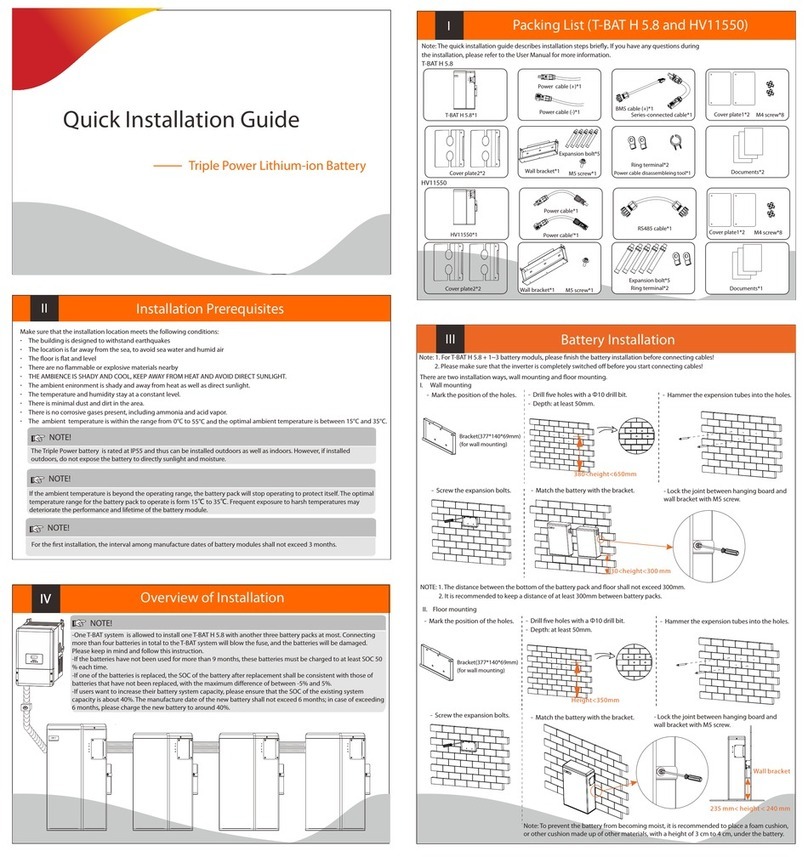
SolaX Power
SolaX Power T-BAT H 5.8 Quick installation guide
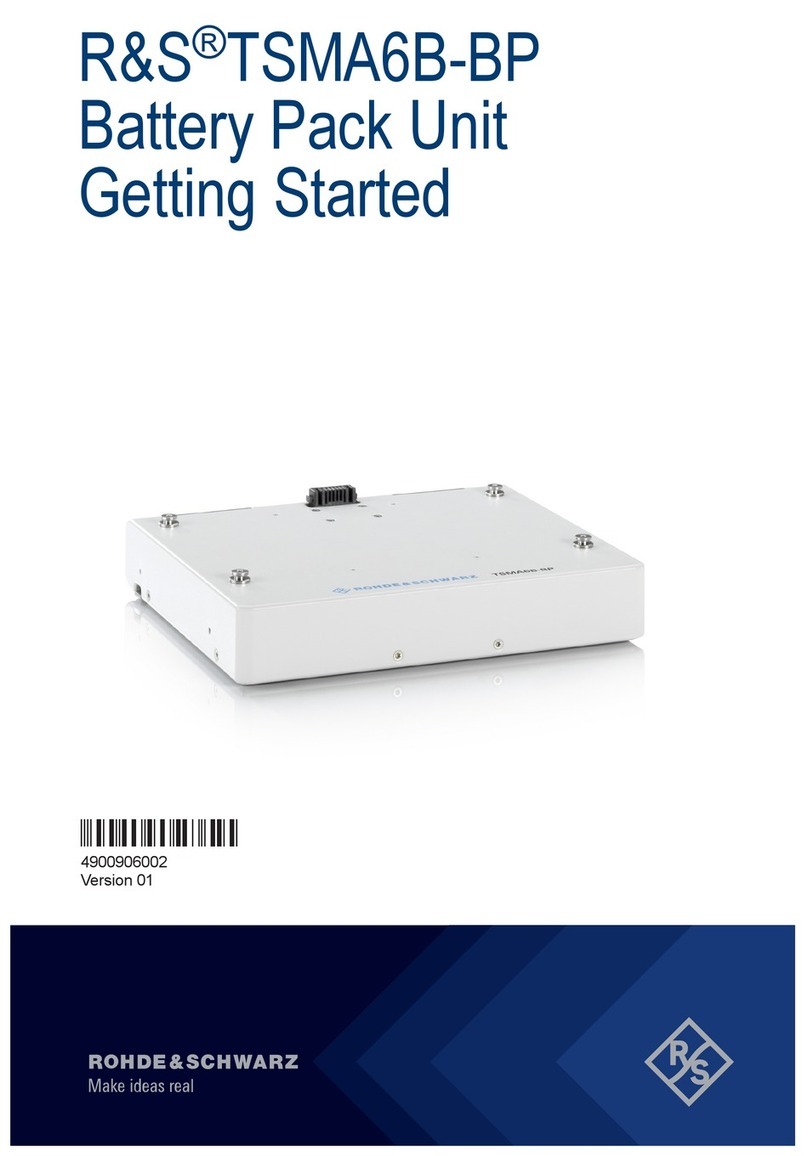
Ronde & Schwarz
Ronde & Schwarz R&S TSMA6B-BP Getting started
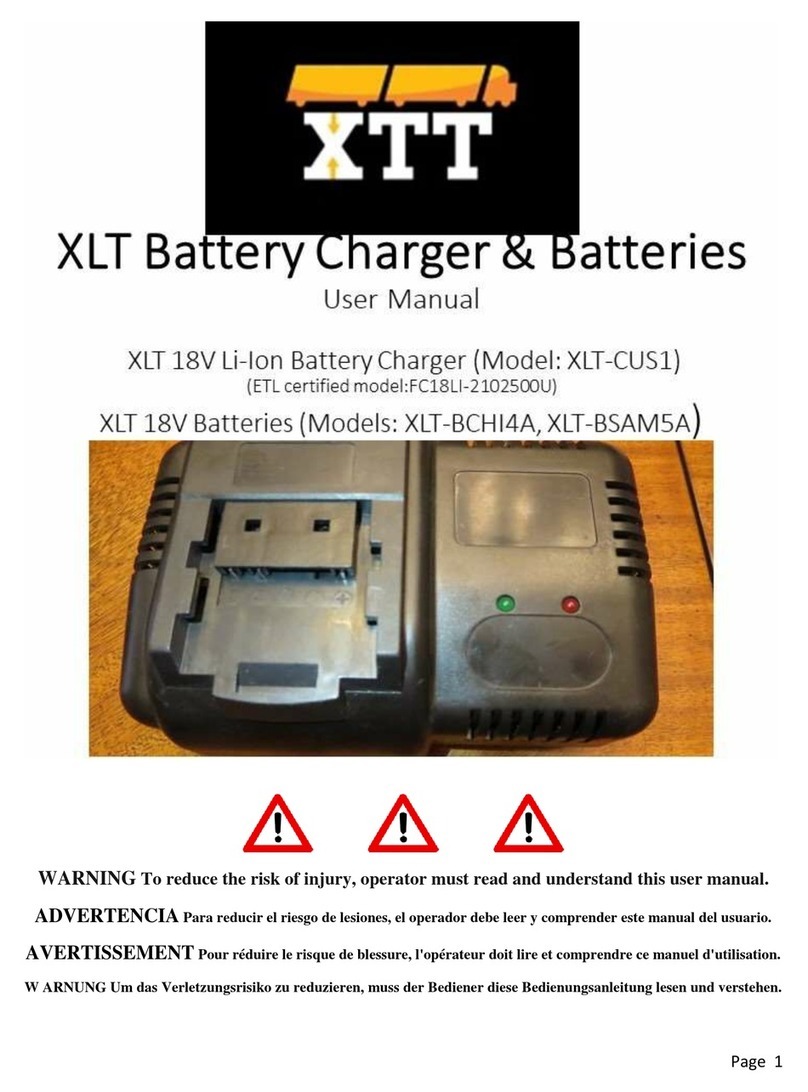
XTT
XTT XLT Series user manual
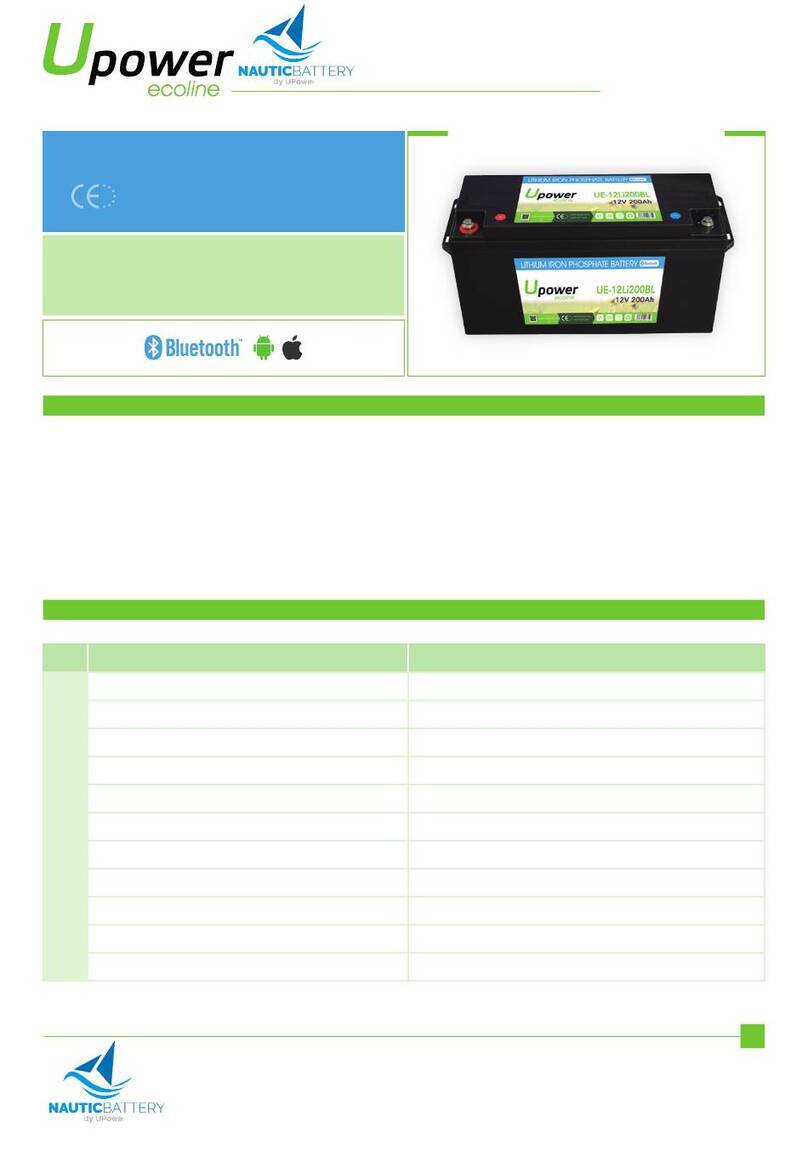
UPOWER Ecoline
UPOWER Ecoline NauticBattery NA-12Li200BL quick start guide
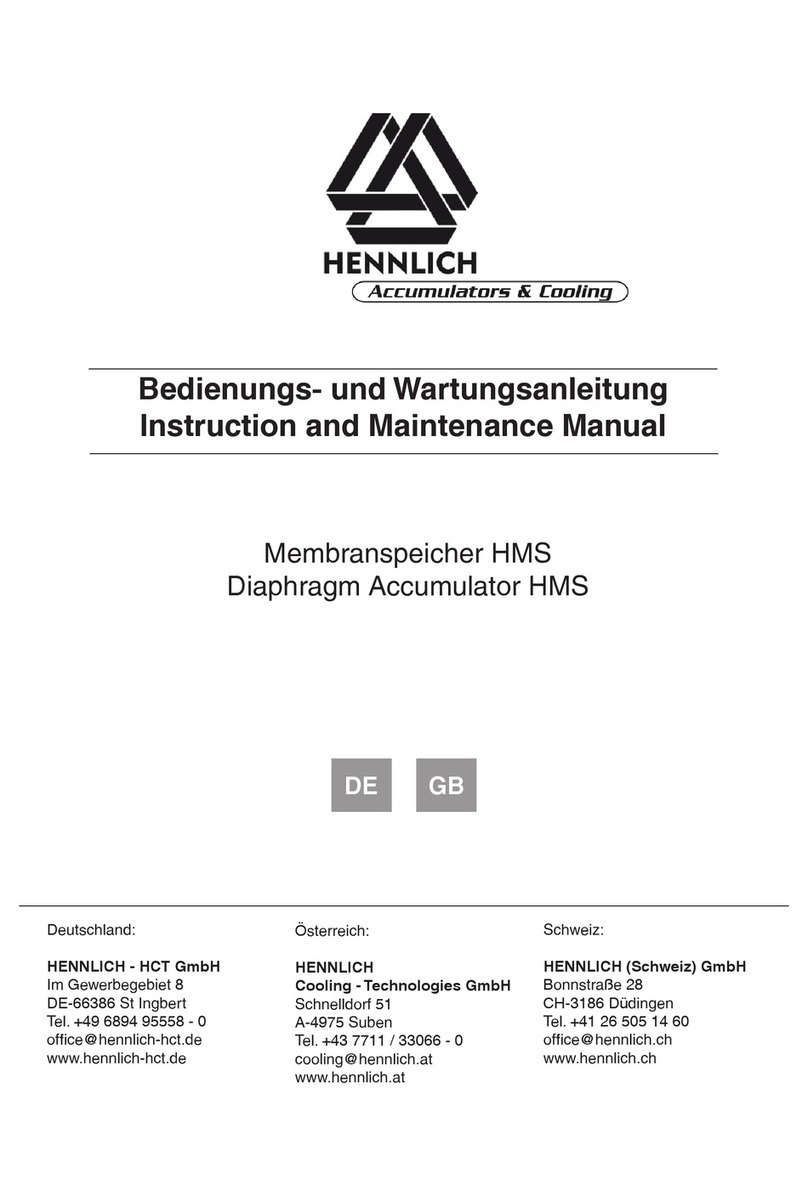
Hennlich
Hennlich HMS Series Instruction and maintenance manual
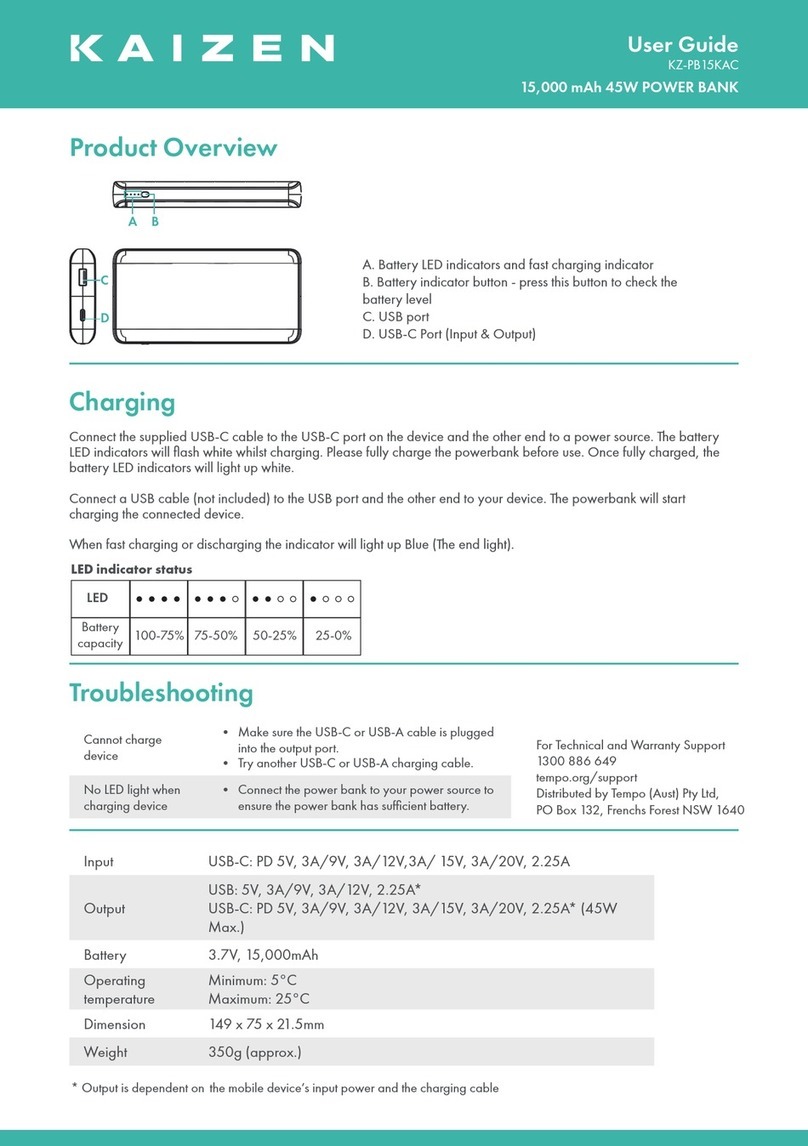
Kaizen
Kaizen KZ-PB15KAC user guide

